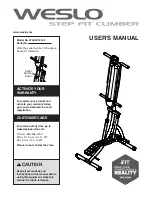
- A D3 Q4 R34 Q8 R45 R46 D3 B [OFF HOOK]
21.4. Transmitter/Receiver
Base Unit and Handset mainly consist of RF Module and DECT BBIC.
Base Unit and Handset transmit/receive voice signal and data signal through the antenna on
carrier frequency.
Signal Pass:
*Refer to
SIGNAL ROUTE
().
21.4.1. Transmitter Block
The voice signal input from the TEL LINE interface goes to RF Module (IC4) through DECT BBIC
(IC2) as shown in
BLOCK DIAGRAM (BASE UNIT)
()
The voice signal passes through the analog part of IC2 where it is amplified and converted to a
digital audio stream signal. The burst switch controller processes this stream performing
encryption and scrambling, adding the various other fields to produce the GAP (Generic Access
Profile) standard DECT frame, assigning to a time slot and channel etc.
In IC4, the carrier frequency is changing, and frequency modulated RF signal is generated and
amplified, and radiated from antenna. Handset detects the voice signal or data signal in the
circuit same as the following explanation of Receiver Block.
21.4.2. Receiver Block
The signal of 19.2 MHz band (18.81792 MHz ~ 18.97344 MHz) which is input from antenna is
input to IC4 as shown in
BLOCK DIAGRAM (BASE UNIT)
().
In IC4, the signal of 19.2 MHz band is downconverted to 864 kHz signal and demoduleted, and
goes to IC2 as GAP (Generic Access Profile) standard DECT frames. It passes through the
decoding section burst switch controller where it separates out the frame information and
performs de-encryption and de-scrambling as required. It then goes to the DSP section where it
is turned back into analog audio. This is amplified by the analog front end, and goes to the TEL
LINE Interface.
22. BLOCK DIAGRAM (HANDSET)
23. CIRCUIT OPERATION (HANDSET)
23.1. Outline
Handset consists of the following ICs as shown in
BLOCK DIAGRAM (HANDSET)
().
- DECT BBIC (Base Band IC): IC1
- All data signals (forming/analyzing ACK or CMD signal)
71
Summary of Contents for KX-TCA151AZV
Page 9: ...9 ...
Page 13: ...6 3 Setting the Ringer Volume 6 3 1 Base Unit 13 ...
Page 14: ...6 3 2 Handset 6 4 Settings Menu Chart 6 4 1 Base Unit 14 ...
Page 15: ...6 4 2 Handset 6 5 PIN Code 6 5 1 Base Unit 15 ...
Page 25: ...Answering System 25 ...
Page 29: ...29 ...
Page 30: ...8 4 2 Entering Names Characters 30 ...
Page 31: ...Cross Reference Phonebook Character Table 8 4 3 Phonebook Character Table 31 ...
Page 32: ...8 4 4 Storing the Number in the Handset Phonebook 32 ...
Page 33: ...8 4 5 Hot Keys Speed Dial 33 ...
Page 35: ...8 5 Handset Registration to a Base Unit 35 ...
Page 36: ...Note for Service At step 7 enter Finally Handset will be linked to Base Unit 36 ...
Page 37: ...8 6 Base Unit Selection 37 ...
Page 44: ...44 ...
Page 45: ...Cross Reference 11 3 2 Handset 45 ...
Page 67: ...2 Put the probes at the receiver terminals as shown below 67 ...
Page 74: ...26 CPU DATA BASE UNIT 26 1 IC2 BBIC 74 ...
Page 95: ...95 ...
Page 97: ...34 ACCESSORIES AND PACKING MATERIALS 97 ...
Page 98: ...34 1 KX TCD510ALV 34 2 KX TCA151AZV 98 ...
Page 99: ...35 TERMINAL GUIDE OF THE ICs TRANSISTORS AND DIODES 35 1 Base Unit 99 ...
Page 115: ...PbF R1 R2 TP4 TP1 TP2 TP3 Digital Volt Meter 12Ω 2W A DC Power Supply 6V ...
Page 130: ...PbF D1 J1 CIRCUIT BOARD CHARGER UNIT Component View ...
Page 131: ...PbF R1 R2 TP4 TP1 TP2 TP3 CIRCUIT BOARD CHARGER UNIT Flow Solder Side View ...
Page 134: ...IC3 IC2 IC1 IC10 PbF Marked ...
Page 136: ...PbF D1 J1 Marked PbF R1 R2 TP4 TP1 TP2 TP3 Marked Component View Flow Solder Side View ...
















































